|
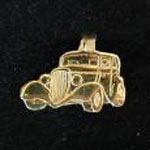 Project COBRA'33 Project COBRA'33 The Engine:A 1933 Ford Flat-Head
V-8
The Engine:A 1933 Ford Flat-Head V-8
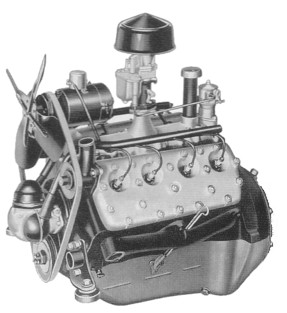
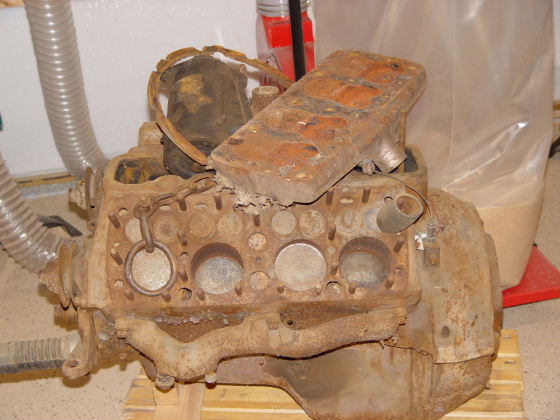
For the last 35 years this is how I have know our Flat-Head V-8, Dirty,
broken and basically a heavy rusted paper weight. It was clear to me early on that I would not be using a Flat-Head engine
to propel Project Cobra'33. Instead we went with a more modern approach and used the Ford Modular 4.6L V-8. But still
the Flat-Head engine was intriguing, so I kept it around for a future project. Looking back, maybe we should have used the
flat-head engine?? It would have been much easier to install...the hood would have fit without interfeerance..and the look
would have been different. Cost wise, it would have been cheaper...much cheaper. I guess I'll only know once we get finished
and see how everything ends up? For now, I'm curious and
nosy about how these engines work and how they go together. I had the engine Sand-Blasted when "What-a-Blast" came
to sand-Blast the body. He did a good job cleaning all the dirt and old paint off the block , oil pan and several other pieces
we had Doug shoot. Right after it was sand-Blasted I started in on the dis-assembly. We loaded it up on the engine lift and
wheeled it over to the counter. I would have never thought it still had oil in the crank-case, not after all these years.
But thanks to normal precautions, I put a drain pan under the block and sure enough it did, about 4 quarts of nice looking
oil drained out. I was expecting more like tar, if anything at all. This now has me more excited about the dis-assembly, now
I know I'll be working with clean, working parts, not the rusted and locked up parts I had in-visioned. 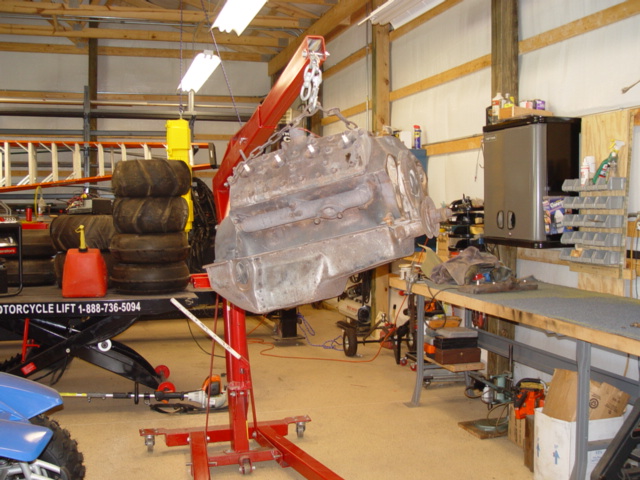
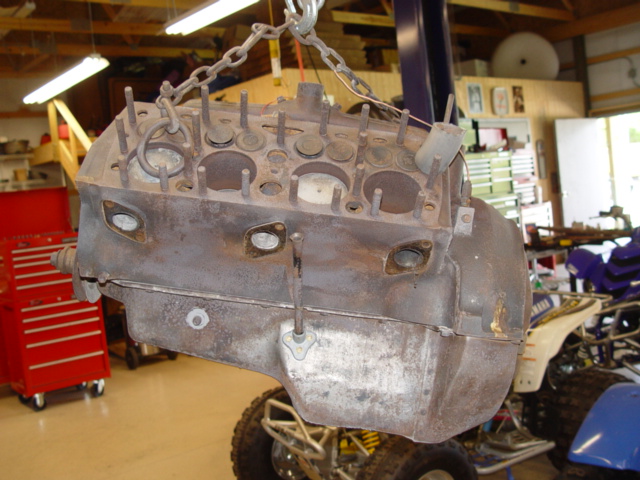
Hear we are...the block right after it was Sand-Blasted by "What-a-Blast". Engine Identification This is something I never figured on, I just assumed it was a 1933 Ford Flathead V-8. But just giving a look
over I quickly seen it was definitely not a 1933 V-8, the two (2) water pumps located in the engine block was a clear give-a-way
that some one replaced this engine with a latter model Passenger V-8, something more like a 1939 or later V-8. Early Ford Serial Numbers
For Cars and Trucks Manufactured for the USA Market from 1932 to 1953 | | | Model Year | Make and Engine | Passenger Car Model (note a) | First Serial Number
(See
note B below) | | 1932 | V8 | 18 | 18- 001 to 18- 203,126 | | 1933 | V8 | 40 | 18-
203,127 to 18- 457,477 | | 1934 | V8 | 40 | 18- 457,478 to 18-1,234,356 | | 1935 | V8 | 48 | 18-1,234,357
to 18-2,207,110 | | 1936 | V8 | 68 | 18-2,207,111 to 18-3,331,856 | | 1937 | V8 - 60hp
V8 - 85hp | 74
78 | 54- 6,602 to 54- 358,334
18-3,331,857 to 18-4,186,446 | | 1938 | V8 - 60hp
V8
- 85hp | 82A
81A | 54- 358,335
18-4,186,447 to 18-4,661,000 (f) | | 1939 | Ford V8 - 60hp
Ford V8 - 85hp
Mercury V8 - 90hp | 922A
91A
99A | Continued from 1938 to 54-506,500
(d)
18-4,661,001 to 18-5,210,700 (e)
99- 001 | | 1940 | Ford V8
- 60hp
Ford V8 - 85hp
Mercury V8 - 90hp | 022A
01A
09A | 54-0,506,501 to end (g)
18-5,210,701 to 18-5,896,294
99A-101,701 | | 1941 | Ford V8
- 90hp
Ford 6 - 90hp
Mercury V8 - 95hp | 11A
1GA
19A | 18-5,896,295 to 18-6,769,035
1GA-000,001 to 1GA-034,800
99A-257,101 | | 1942 | Ford V8 - 90hp
Ford
6 - 90hp
Mercury V8 - 100hp | 21A
2GA
29A | 18-6,769,036 to 18-6,925,898
1GA-034,801 to 1GA-227,523
99A-466,701 | | 1946 | Ford V8 - 100hp
Ford 6 - 90hp
Mercury
V8 - 100hp | 69A
6GA
69M | 99A-650,280 to 99A-1,412,709
1GA-227,524 to 1GA- 326,417
99A-650,280 to 99A-1,412,709 | | 1947 | Ford V8 - 100hp
Mercury V8 - 100hp
Ford 6 - 90hp
(G)
Ford 6 - 90hp (H) | 79A
79M
7GA
---- | 799A-1,412,708
to 799A-2,071,117 (i)
799A-1,412,708 to 799A-2,071,117
71GA- 326,418 to 71GA-
414,366
77HA- 0,512 to 77HA- 9,038 (c) | | 1948 | Ford V8 - 100hp
Ford 6 - 90hp
Mercury
V8 - 100hp | 89A
8GA
89M | 899A-2,071,118 to
899A-2,374,315
87HA- 0,536 to 87HA- 073,901 (i)
899A-2,005,028 to 899A-2,374,315
| | 1949 | Ford V8
- 100hp
Ford 6 - 95hp
Mercury V8 - | 8BA
8HA
9CM | 98BA-101
98HA-101
9CM -101 | | 1950 | Ford V8 - 100hp
Ford 6 - 95hp
Mercury
V8 - | 0BA
0HA
0CM | B0-100,001 (J)
H0-100,001
50-100,001M | | 1951 | Ford
V8 - 100hp
Ford 6 - 95hp
Mercury V8 - | 1BA
1HA
1CM | B1-100,001 (J)
H1-100,001
51-100,001M | | 1952 | Ford V8 - 110hp
Ford
6 - 101hp
Mercury V8 - | B2
A2
(All) | A2-100,001 (J)
B2-100,001
52-100,001M | | 1953 | Ford V8 - 110hp
Ford 6
- 101hp
Mercury V8 - | B3
A3
(All) | A3-100,001
(J)
B3-100,001
53- 5,001H |
|
(a) The serialization applied to trucks and commercial vehicles using these Ford engines. They may
have different serial prefixes, but would be inclusive within the serial ranges shown. In other words, passenger car totals
must be combined with truck and commercial vehicles to arrive at total usage of the engine production numbers shown. (b) The serial numbers were stamped on the vehicles without any commas or superfluous 0's (zeros).
They have been shown here to help identify the general starting number. For instance, the first 1939 Mercury would have a
"99-1" stamped as its serial number (rather than 99-001as shown above). (c)
Ford changed production on October 3, 1947 from the G series to the new H series six cylinder engine. They started new serial
numbers for the new engine. (d) The available records do not show the beginning
number for 1939 models with the 60hp V8 engine. According to the Early Ford V8 Club 1938-39 Ford reference book, Ford held
up production of the 60hp engine for awhile due to overstock. They stopped building the engine at #54-468,967 on December
23, 1937 and did not resume production until April 20, 1939 with #54-476,288. "The Standard Catalog of Ford 1903-2003"
gives production numbers of 38,197 coupes, 124,866 Tudors, unknown # of Fordors, and 3,277 Station Wagons with the 60hp V8
engines. No data for trucks and commercial vehicles with 60hp V8's is given, so the total number for 1939 is unknown.
(e) According to the same EFV8 Club reference book, the first model year 1939
production V8 (85hp) was #18-4,657,660 which was built Sept. 6, 1938. This conflicts with the "first" number listed
above (a difference of 3,341 units). (f) In the 1938 model year Ford changed
from the 21 stud 85hp V8 to the 24 stud engine. The change occurred with #18-4,380,120 on November 24, 1937. (g) Per "The Standard Catalog of Ford 1903-2003" total production of
1940 passenger vehicles with the 60hp V8 is 231,425 units (including coupes, Tudors, Fordors, & station wagons). This
does not include additional totals of 60hp engines used in trucks and commercial vehicles.
(h)
For more complete Data Plate decoding information on 1949 thru 1953 Ford cars, refer to the decoding chart. Additional letters
between the beginning two digits (letter/number) and the rest of the serial number indicate the assembly plant location. Refer
to the decoding chart. (i) Letter from the Ford Motor Company to
all Ford offices (dated Nov. 4, 1947): "Engine and model numbers for 1948 (Ford) cars - the lowest number used with 1948
prefixes for six-cylinder passenger car engines is 87HA-0536. Lowest number used with 1948 prefixes for V-8 passenger car
engines is 899A-1984859. Due to inventory of engines at various assembly plants, some 1947 models will have higher numbers
than the above. However, the prefix changes will definitely identify the 1948 models from the 1947 models." The serial
numbering shown in the chart above reflects this numbering variance. (j)
On 1950 thru 1953 models (and beyond) any additional letters between the basic model letters and serial numbers denote the
assembly plant. Other: From 1932 through 1948 vehicles, Ford Motor Company stamped
the serial number into the top of the driver's side frame rail in three locations. This same number was also stamped into
the top of the transmission-to-engine housing portion of the transmission. This location was visible when the floorboard and
transmission cover plate were removed (click here for a picture example). Of the frame-stamped serial numbers, only the forward-most stamping was visible when looking down into the engine compartment
(located between the front crossmember and the dash (firewall). The two other frame locations are visible only when the body
is removed from the frame. The serial numbers were metal stamped with numbers/letters approximately 1/4" in height. The number (including the prefixes shown) was always preceded by (and followed by) a stamped "star" similar
to an asterisk. It is believed that this was done to prevent someone from fraudulently adding a digit to the beginning or
ending of a serial number in order to alter its identification. From the Ford Service Bulletins there is a bulletin
dated April 15, 1938 that refers to "Engine Numbers". The subject covers the use of the correct stamps when reconditioned
cylinder assemblies are stamped by dealers. The bulletin goes on to say that the dealers should use the K.R. Wilson number
A404B stamp set. The 1940 K.R. Wilson tool catalog shows the A404B stamp set of 11 stamps (numbers 0 thru 9 plus the "star").
The same catalog shows a new number A404 stamp set of three (just the 6 stamp, the 9
stamp, and the I stamp). The K.R. Wilson catalog states that "The
design of engine numbers has been changed to lessen the possibility of outside individuals attempting to change engine numbers.
The figures I-6-9 have been changed. Dealers should immediately provide themselves with the new figures - One-Six-Nine. See
Ford Service Bulletin, Subject No. 6000 (Engine) Page 22." 
The diagram above is from the 1940 K.R. Wilson Catalog of Service Tools &
Garage Equipment, and was included with the notes about the change in stamps. The primary differences were the numbers 6
and 9, and the number 1 becoming more like a capital "i" in appearance. On 1949 and 1950 cars the number was stamped on the dash panel (firewall) under the hood. In 1951 the number was
stamped in a plate which was mounted on the dash panel (firewall) under the hood. For early 1952 models the number was on
a plate mounted on the right front door pillar post. The late '52 through '55 models (except '55 T-Bird) had the
number on a plate on the left front door pillar post. Resources: The information
given in this chart is based on the data given in "MOTOR'S AUTO REPAIR MANUAL". Two versions were referenced:
the 1935 to 48 book and the 1946 to 56 book. Also, "The 1938-39 Ford Book" published by the Early Ford V8 Club of
America. Also, "The Standard Catalog of Ford 1903-2003" published by Krause Publications. Also, the reprinted "Ford
V-8 Service Bulletins (1938-1940 Complete)" published by Post Motor Books. Also, the K. R. Wilson 1940 Catalog of Service
Tools and Garage Equipment. We have found some conflicting information on serial numbers (surprised?) but have generally used
the data from the Early Ford V8 Club Album when statistics from other sources was different. Caveat! In reviewing the various source of serial number information
(and we have not even researched them all) we find that there are some discrepancies. Sometimes, the Ford record keeping was
not entirely correct. Some serial numbers within a sequence were simply never assigned to a vehicle. Other details that don't
make sense prevent us some assuming 100% reliability in these statistics. As confirmed details become available to us, we
will add reference notes or make corrections as necessary. 
Charts and drawing from "Ford Flathead V8 Engines and Transmissions"
|

